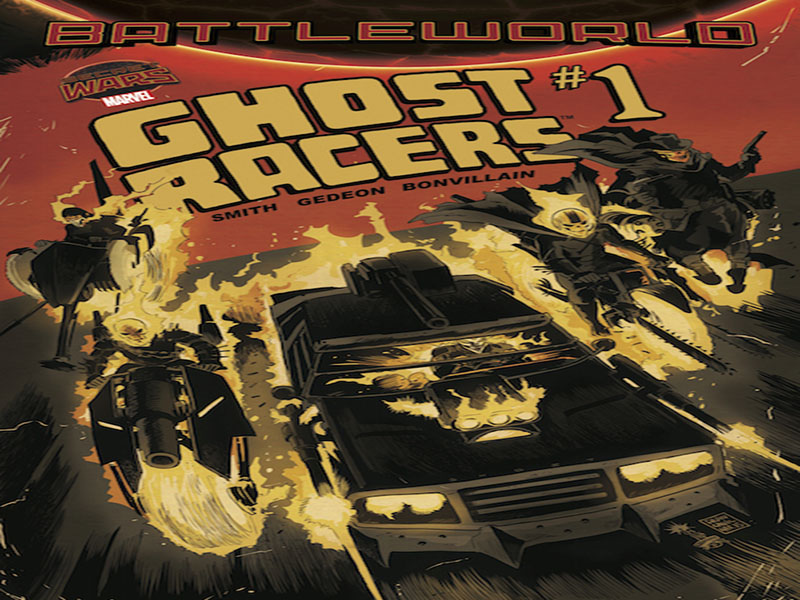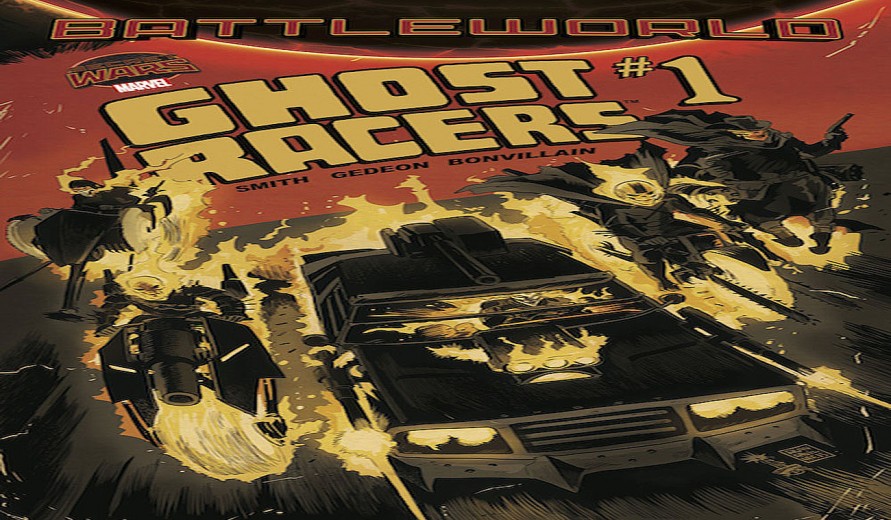
Before Michael B. Jordan stirred up controversy for his portrayal of the, otherwise Caucasian, superhero known as Johnny Storm (aka The Human Torch) in the upcoming reboot of the Fantastic Four, Marvel writers, artists and editors were already making strides in adding some color to the comic book canvas. Characters like the African American/Puerto Rican Miles Morales, took on the Spider Man mantle, and Kamala Khan, a Muslim girl from Jersey became the new Ms. Marvel. Yet, another popular character that came out of this movement was a Mexican American teenager from East L.A. by the name of Robbie Reyes, who took on the supernatural powers of the Spirit of Vengeance, Ghost Rider.
Created by artist/writer Felipe Smith, Robbie Reyes quickly became a fan favorite – even landing a cover on Lowrider magazine because this Ghost Rider drives a tricked out muscle car unlike his bike and horse-riding predecessors. Smith – who is of Jamaican and Argentine descent – credits Robbie’s popularity not on the fact that he is Latino, but rather because the character is relatable.
“Robbie is a very accessible character. He’s a character that regardless of what your own background is, I think you can read his story and understand who he really is. He’s a very responsible kid. He’s young, but he’s grown up without parents and having to take care of his developmentally disabled brother named Gabe since a young age. I think that’s something that anyone can relate to – just seeing this character struggle but still being able to make the best of it,” Smith shared.
But what about the man who puts pen to pulp creating this latest incarnation of the Marvel superhero? For a closer look at the origin story of Felipe Smith read on through.
Portrait of the Artist
Born in Akron, Ohio, Smith and his family moved to Buenos Aires, Argentina, when he was five-years-old. Smith did most of his schooling there where he discovered that his passion in life was drawing. Later in life, he moved back to the States where he attended the School of the Arts Institute of Chicago. After graduating, Smith decided to head west to pursue a career in animation in Los Angeles.
“I moved to L.A. ready to get a job in animation and ready to be a professional artist, and that didn’t happen right away [laughs]. So, I ended up working a lot of part time, minimum wage jobs at restaurants and karaoke bars and postal centers,” he said. However, working those jobs, and getting to meet different types of people and experiencing some wild situations, gave Smith the direction he needed. “I decided that I was going to write about what I was going through: I had just graduated from art school, I owed a ton of money in student loans, and I didn’t have a job where I made enough for me to be able to even make the monthly payments. I was being harassed by bill collectors, and I was working at this postal center. People show up to get their money orders, and when the machine doesn’t work they show up with baseball bats. It may sound crazy, but these are all things that I was going through. I was like, ‘This is completely entertaining as a story.’ These situations play out normally in everyday life and people relate to them,” Smith said.
American publishers, however, weren’t as excited about Smith’s stories. “I’d go to a couple of conventions, like San Diego Comic Con, and when I showed my work to the publishers they were like, ‘Are you crazy? You’re never going to get this published!’” Smith recalled. Determined to find an outlet for his stories, Smith decided to look to other horizons in order to bring his creations to the masses. “When I first moved to L.A., I went to a Japanese bookstore for the first time. Their comic book section blew my mind. I saw the variety of different art styles in these books and subject matter, and I wouldn’t see one single punch thrown [in the stories], nobody flying. It would just be people talking, wearing suits, and kind of just drinking tea, and just going about their day. That really put things into perspective for me,” he said.
Smith found a way to connect with the Japanese comic book scene, by entering a Manga contest online. The grand prize was a three-book deal with a large American-based company that licensed Japanese titles in English. Even though Smith didn’t win first place, his entry impressed the company enough that they still gave him a three-book deal. The buzz about Smith’s series reached Japan, and around the time he was wrapping up his third volume, Smith received an email from a prominent book agent who was interested in representing Smith in Japan. “This lady Yukari Shiina became my agent. We had a meeting with the Editor-In-Chief at Kodansha, which is the biggest publisher in Japan. I got a contract with Kodansha, and I went on to release a three volume series called Peepo Choo,” Smith stated.
The Return and Reincarnation
After his adventures with Peepo Choo in Japan, Smith returned to L.A. where he landed a gig doing character designs on Nickelodeon’s “Teenage Mutant Ninja Turtles” series. A year later, he received a call from Marvel Comics Editor Mark Paniccia extending an invitation to help them create a new rendition of Ghost Rider.
“Ghost Rider’s a cool character, but I also thought of those Nick Cage movies. A lot of stuff had been done with the character, which I didn’t think was the best stuff out there,” Smith admitted, but Smith instantly changed his mind when Paniccia said he had free rein. There were just two stipulations: the new character had be younger than the other Ghost Riders who were in their 30s, and he had to drive a car instead of a motorcycle.
With the freedom to basically do anything he wanted with the character, Smith used his L.A. environment as the setting to Robbie Reyes’ story. “I wanted to make him from L.A. with the drag racing in my surroundings,” he told us of the character. “I wanted to be more grounded because when you write about things you know, they come off very natural.” Then, it came down to the race culture in L.A. “The two demographics that are predominately into car culture are either Asians or Hispanics in Los Angeles,” Smith explained. “Being Latino myself, and having grown up in Argentina, I knew that I could write a Latino character pretty well.”
The popular character gained so much traction that Marvel brought Smith back onboard, alongside artist Juan Gedeon of Argentina, to create the Secret Wars storyline for Ghost Rider titled Ghost Racers, a death race-like tale that pins Robbie up against a couple of other Ghost Riders from the past—like Johnny Blaze, Danny Ketch, Carter Slade and the Nicaragüensa, Alejandra Blaze—in a high-octane competition to preserve their souls. The first issue of Ghost Racers went on sale on June 10th.
The Lesson
When it comes to the ignition key to success, Smith offered up the following words of wisdom: “People will tell you that you’re not good enough, but if you’re really excited about it, just work hard. I wouldn’t say ignore what they’re telling you—a lot of times what they’re telling you are things that are true, but don’t let them dishearten you and make you stop.”
To purchase the new Ghost Rider and any other Marvel Titles, simply click here

